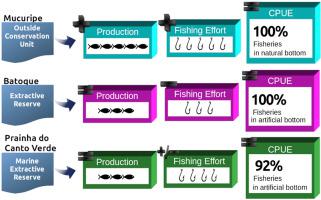当前位置:
X-MOL 学术
›
Ocean Coast Manage.
›
论文详情
Our official English website, www.x-mol.net, welcomes your feedback! (Note: you will need to create a separate account there.)
Dynamics of artisanal fisheries performed with hook-and-line gear under different management regimes in Brazil
Ocean & Coastal Management ( IF 4.6 ) Pub Date : 2021-02-01 , DOI: 10.1016/j.ocecoaman.2020.105403 Jasna Maria Luna Marques , Raúl Cruz , Caroline Vieira Feitosa
Ocean & Coastal Management ( IF 4.6 ) Pub Date : 2021-02-01 , DOI: 10.1016/j.ocecoaman.2020.105403 Jasna Maria Luna Marques , Raúl Cruz , Caroline Vieira Feitosa

|
Abstract Artisanal fisheries are a source of livelihood for small-scale fishermen around the world. The risk of overfishing is a constant concern. The establishment of conservation units is a strategy to alleviate the pressure on fishing stocks. In the State of Ceara, there are two conservation units in the category of extractive reserves (Resex) 1 . This study characterized the dynamics of the artisanal fishing of the hook-and-line fleet in three communities with different modes of use. Data were collected by monitoring the landings twice a month from 2017 to 2019 at Mucuripe beach, Batoque Resex and Prainha do Canto Verde 2 (PCV) Marine Resex, State of Ceara, Brazil. Data were collected for biomass (B), fishing effort (f), species composition, fishing ground and type of bottom habitat. A total of 234 vessels were sampled and 85 species were identified at the three sites, showing that the use of fisheries targets multiple species. The Kruskal-Wallis test was applied to analyze the production and fishing effort data. The largest landing was shown at Mucuripe (10.16 ton), which also had the highest mean production (224 kg). Mucuripe employed the highest mean effort (2711 hook*hour) and showed the highest number of species per boat, and Batoque the lowest (48 hook*h). Two-way ANOVA was used to test differences in richness and catch per unit effort 3 (CPUE) across sites and between seasons. There was no difference in CPUE across sites. The species richness was different across sites, with the highest average in Mucuripe (6.4 species per boat) and the lowest in PCV (3.6 species per boat). There was no variation in species richness between seasons. The correspondence analysis identified a strong association of the ballyhoo halfbeak, corocoro grunt, chere-chere grunt, Atlantic spadefish and Atlantic thread herring with the artificial hard bottom habitat, and a correlation of the guachanche barracuda and black grouper to the natural hard bottom. In both Resex, more specimens were caught in artificial structures and in Mucuripe in natural bottom habitats. The linear regression analysis indicated a significant relationship between effort (f) and biomass (B) in Batoque and PCV. There was no relationship between f and CPUE in both reserves. In this study, it was observed that the choice of fishing grounds and bottom habitat influenced the composition of species caught by the artisanal fleet. No difference in fishing production was found across the studied sites under different types of management.
中文翻译:

巴西不同管理制度下使用钩线渔具进行的手工渔业动态
摘要 手工渔业是世界各地小规模渔民的生计来源。过度捕捞的风险一直是人们关注的问题。建立保护单位是缓解渔业资源压力的一种策略。在塞阿拉州,有两个保护区属于采掘保护区 (Resex) 1 类别。这项研究描述了三个不同使用模式社区中钩钓船队手工捕鱼的动态。数据是通过从 2017 年到 2019 年每月两次在巴西塞阿拉州的 Mucuripe 海滩、Batoque Resex 和 Prainha do Canto Verde 2 (PCV) Marine Resex 进行监测来收集的。收集了生物量 (B)、捕捞努力量 (f)、物种组成、渔场和底部栖息地类型的数据。在三个地点共对 234 艘船只进行了采样,并确定了 85 个物种,表明渔业的使用针对多个物种。Kruskal-Wallis 检验用于分析生产和捕捞努力量数据。最大的上岸量出现在穆库里佩(10.16 吨),其平均产量也最高(224 公斤)。Mucuripe 采用最高的平均努力(2711 钩*小时),每艘船的物种数量最多,而巴托克最低(48 钩*小时)。双向方差分析用于测试不同地点和季节之间的丰富度和单位努力捕获量 3 (CPUE) 的差异。不同站点的 CPUE 没有差异。不同地点的物种丰富度不同,Mucuripe 平均最高(每船 6.4 种),PCV 最低(每船 3.6 种)。季节间物种丰富度没有变化。对应分析确定了大嘴鲽鱼、corocoro grunt、chere-chere grunt、大西洋黑鲱和大西洋鲱鱼与人工硬底栖息地的强烈关联,以及guachanche梭鱼和黑石斑鱼与天然硬底的相关性。在这两个 Resex 中,更多的标本是在人工结构和自然底部栖息地的 Mucuripe 中捕获的。线性回归分析表明巴托克和 PCV 中的努力 (f) 和生物量 (B) 之间存在显着关系。在两个储备中,f 和 CPUE 之间没有关系。在这项研究中,观察到渔场和海底栖息地的选择影响了手工船队捕获的物种组成。
更新日期:2021-02-01
中文翻译:

巴西不同管理制度下使用钩线渔具进行的手工渔业动态
摘要 手工渔业是世界各地小规模渔民的生计来源。过度捕捞的风险一直是人们关注的问题。建立保护单位是缓解渔业资源压力的一种策略。在塞阿拉州,有两个保护区属于采掘保护区 (Resex) 1 类别。这项研究描述了三个不同使用模式社区中钩钓船队手工捕鱼的动态。数据是通过从 2017 年到 2019 年每月两次在巴西塞阿拉州的 Mucuripe 海滩、Batoque Resex 和 Prainha do Canto Verde 2 (PCV) Marine Resex 进行监测来收集的。收集了生物量 (B)、捕捞努力量 (f)、物种组成、渔场和底部栖息地类型的数据。在三个地点共对 234 艘船只进行了采样,并确定了 85 个物种,表明渔业的使用针对多个物种。Kruskal-Wallis 检验用于分析生产和捕捞努力量数据。最大的上岸量出现在穆库里佩(10.16 吨),其平均产量也最高(224 公斤)。Mucuripe 采用最高的平均努力(2711 钩*小时),每艘船的物种数量最多,而巴托克最低(48 钩*小时)。双向方差分析用于测试不同地点和季节之间的丰富度和单位努力捕获量 3 (CPUE) 的差异。不同站点的 CPUE 没有差异。不同地点的物种丰富度不同,Mucuripe 平均最高(每船 6.4 种),PCV 最低(每船 3.6 种)。季节间物种丰富度没有变化。对应分析确定了大嘴鲽鱼、corocoro grunt、chere-chere grunt、大西洋黑鲱和大西洋鲱鱼与人工硬底栖息地的强烈关联,以及guachanche梭鱼和黑石斑鱼与天然硬底的相关性。在这两个 Resex 中,更多的标本是在人工结构和自然底部栖息地的 Mucuripe 中捕获的。线性回归分析表明巴托克和 PCV 中的努力 (f) 和生物量 (B) 之间存在显着关系。在两个储备中,f 和 CPUE 之间没有关系。在这项研究中,观察到渔场和海底栖息地的选择影响了手工船队捕获的物种组成。


























 京公网安备 11010802027423号
京公网安备 11010802027423号